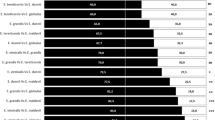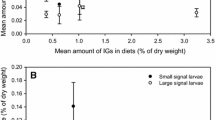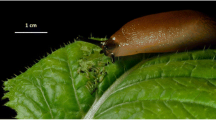Abstract
Aromatic plants dominate in Mediterranean-type ecosystems. They often produce remarkable quantities of essential oils containing high amounts of phenolic isoprenoids, such as thymol and carvacrol. The purpose of this work was to examine the interactions between commonly occurring aromatic plants in the Mediterranean environment and their snail grazers. The aromatic plants used were two Origanum vulgare subspecies, subsp. hirtum and subsp. vulgare. They differ in the content and the qualitative composition of their essential oil; subsp. hirtum contains a much larger amount and is rich in phenolic compounds. Their effect on the foraging behavior of three snail species, native in Greece, was studied; the snail species were Helix lucorum, H. aspersa, and Eobania vermiculata. The snails' responses to different food sources, raw or processed, with or without essential oils, were evaluated during the different stages of the foraging cycle. During the encounter stage, snails were more repelled than attracted when close to phenol-rich foods. During the acceptance stage, all snail species tended to reject food types that contained high concentrations of subsp. hirtum essential oil. At the feeding stage, subsp. hirtum essential oil caused reduction of daily consumption rates. Overall, the essential oil of O. vulgare subsp. vulgare did not produce any marked change in the snails' behavior. In contrast, that of O. vulgare subsp. hirtum had a repellent effect, particularly when present in naturally occurring high concentrations. Among the snail species, H. lucorum, which does not share the same biotope with O. vulgare subsp. hirtum, was the least tolerant to its essential oil.
Similar content being viewed by others
REFERENCES
Bailey, S. E. R., and Wedgwood, M. A. 1991. Complementary video and acoustic recordings of foraging by two pest species of slugs on non-toxic and molluscicidal baits. Ann. Appl. Biol. 119:163–176.
Bailey, S. E. R., Cordon, S., and Hutchinson, S. 1989. Why don't slugs eat more bait? A behavioral study of early meal termination produced by methiocarb and metaldehyde baits in Deroceras caruanae, pp. 385–390, in I. Henderson (ed.). Slugs and Snails in World Agriculture. BCPC Mono. 41.
Dirzo, R. 1980. Experimental studies on slug-plant interactions: 1. The acceptability of thirty plant species to the slug Agriolimax caruanae. J. Ecol. 68:981–998.
Gouyon, P. H., Fort, P. H., and Caraux, G. 1983. Selection of seedlings of Thymus vulgaris by grazing slugs. J. Ecol. 71:299–306.
Hunter, P. J., and Symonds, B. V. 1970. The distribution of bait pellets for slug control. Ann. Appl. Biol. 65:1–7.
Ietswaart, J. C. 1980. A taxonomic revision of the genus Origanum (Labiatae). Leiden Botanical Series, Vol. 4. Leiden University Press, The Hague.
Kokkini, S., and Vokou, D. 1989. Carvacrol-rich plants in Greece. Flavor Fragr. J. 4:1–7.
Kokkini, S., Karagiannakidou, V., Hanlidou, E., and Vokou, D. 1988. Geographical and altitudinal distribution of the Lamiaceae in Greece. Phyton (Horn, Austria) 28:215–228.
Kokkini, S., Vokou, D., and Karousou, R. 1991. Morphological and chemical variation of Origanum vulgare L. in Greece. Bot. Chron. 10:337–346.
Lazaridou-Dimitriadou, M., and Daguzan, J. 1978. Consommation alimentaire, production et bilan énergetique chez Euparypha pisana (Muller) (Gasteropode Pulmone). Ann. Nutr. Aliment. 32:1317–1350.
Lazaridou-Dimitriadou, M., and Kattoulas, M. E. 1981. Contribution a l'étude de la biologie et de la croissance des escargots commercialisés en Grèce: Eobania vermiculata (Muller). Haliotis 11:129–137.
Lazaridou-Dimitriadou, M., and Kattoulas, M. E. 1985. Edible and Commercialized Snails of Greece—Heliciculture. Giachoudi-Giapouli Publications, Thessaloniki (in Greek).
Lincoln, D. E., and Langenheim, J. H. 1979. Variation of Satureja douglassii monoterpenoids in relation to light intensity and herbivory. Biochem. Syst. Ecol. 7:289–298.
Linhart, Y. B., and Thompson, J. D. 1995. Terpene-based selective herbivory by Helix aspersa (Mollusca) on Thymus vulgaris (Labiatae). Oecologia 102:126–132.
Maarse, H., and van Os, F. H. L. 1973. Volatile oil of Origanum vulgare L. ssp. vulgare. I. Qualitative composition of the oil. Flavour Ind. 4:477–481.
Margaris, N. S. 1981. Adaptive strategies in plants dominanting Mediterranean-type ecosystems, pp. 309–315, in F. di Castri, D. W. Goodall and R. L. Specht (eds.). Mediterranean-type Shrublands. Elsevier Scientific Publishing, Amsterdam.
Mooney, H. A., and da Silva, J. V. 1981. Photosynthesis and allocation, p. 39, in N. S. Margaris and H. A. Mooney (eds.). Components of Productivity of Mediterranean-climate Regions; Basic and Applied Aspects. Dr. W. Junk Publishers, The Hague.
Petanidou, T., and Vokou, D. 1993. Pollination ecology of Labiatae in a phryganic (East Mediterranean) ecosystem. Am. J. Bot. 80:892–899.
Pfreger, V., and Chatfield, J. 1988. A guide to snails of Britain and Europe. Hamlyn, London.
Phillipson, J. 1960. A contribution to the feeding biology of Mitopus morio (F.) (Phalangida). J. Anim. Ecol. 29:35–43.
Rice, L. R., Lincoln, D. E., and Langenheim, J. H. 1978. Palatability of monoterpenoids compositional types to a molluscan herbivore Ariolimax dolichophallus. Biochem. Syst. Ecol. 6:45–53.
Senseman, D. 1978. Short term control of food intake by the terrestrial slug Agriolimax. J. Comp. Physiol. 28:29–39.
Sokal, R. R., and Rohlf, F. J. 1981. Biometry: The Principles and Practice of Statistics in Biological Research, 2nd ed. W. H. Freeman and Co., New York.
Vokou, D. 1992. The allelopathic potential of aromatic shrubs in phyrganic (East Mediterranean) ecosystems, pp. 303–320, in S. J. H. Rizvi and V. Rizvi (eds.). Allelopathy: Basic and Applied Aspects. Chapman and Hall, London.
Vokou, D., and Margaris, N. S. 1986a. Autoallelopathy of Thymus capitatus. Acta Oec.-Oecol. Plant. 7:157–163.
Vokou, D., and Margaris, N. S. 1986b. Variation of volatile oil concentration of Mediterranean aromatic shrubs Thymus capitatus Hoffmagg et Link, Satureja thymbra L., Teucrium polium L., and Rosmarinus officinalis. Int. J. Biometeorol. 30:147–155.
Vokou, D., and Margaris, N. S. 1988. Decomposition of terpenes by soil microorganisms. Pedobiologia 31:413–419.
Vokou, D., Margaris, N. S., and Lynch, J. M. 1984. Effects of volatile oils from aromatic shrubs on soil microorganisms. Soil Biol. Biochem. 16:509–513.
Vokou, D., Kokkini, S., and Bessiere, J. M. 1993. Geographic variation of Greek oregano (Origanum vulgare spp. hirtum) essential oils. Biochem. Syst. Ecol. 21:287–295.
Wedgwood, M. A., and Bailey, S. E. R. 1988. The inhibitory effects of the molluscicide metaldehyde on feeding, locomotion and fecal elimination of three pest species of terrestrial slug. Ann. Appl. Biol. 112:439–457.
Author information
Authors and Affiliations
Rights and permissions
About this article
Cite this article
Vokou, D., Tziolas, M. & Bailey, S.E.R. Essential-Oil-Mediated Interactions Between Oregano Plants and Helicidae Grazers. J Chem Ecol 24, 1187–1202 (1998). https://doi.org/10.1023/A:1022446919104
Issue Date:
DOI: https://doi.org/10.1023/A:1022446919104




